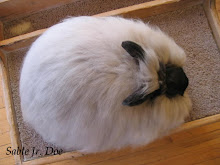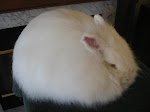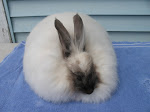Another repost from the old blog:-)
A judge recently offered a wonderful way of evaluating your own rabbits at home. He suggested using a Show Remark Card to "grade" each rabbit individually to get an idea of where each stands in comparison with the others, and then store that card in your rabbit's file either on computer or in some sort of binder. He suggested using this method mostly to gauge Type, but I quickly realized that this would be a fabulous way to assess the Wool on our animals as well!:)
Here are a few sample Type categories for use on a hypothetical "scoresheet". I took these characteristics from a variety of remark card styles/formats that I dug up out of my old show records:
TYPE
Head VG (very good) G (good) F (fair) P (poor)___________________________
Ears VG G F P_________________________________
Bone VG G F P_________________________________
Shoulders VG G F P_________________________________
Midsection VG G F P_________________________________
Hindquarters VG G F P_________________________________
Color VG G F P_________________________________
Meat condition VG G F P_________________________________
Depth VG G F P_________________________________
Overall Type VG G F P_________________________________
WOOL
Density VG G F P__________________________________
Texture VG G F P__________________________________
Length VG G F P__________________________________
Crimp VG G F P_________________________________
Overall Uniformity VG G F P_________________________
Uniformity of length VG G F P_________________________
Uniformity of density VG G F P_________________________
Uniformity of texture VG G F P_________________________
Coat Condition VG G F P_____________________
Ratio Guard Hair/Underwool VG G F P______________________
So what a breeder could do is print out several copies of these 'scorecards' for their rabbits, and then fill in the categories after a thorough evaluation of each animal. The lines at the end of each trait are for optional notes on each animal, and it would probably be a great idea to do evaluations at pre-determined ages for each rabbit in order to compare development of the animals in your line over time (for ex, do your rabbits tend to develop early or late, do they tend to lose "points" in certain categories at certain ages, do you notice trends of good or bad qualities emerging at certain stages of development, etc.). Be sure to place a date on each scorecard.
An evaluation system like this could really help to identify line characteristics that a breeder might never notice otherwise----and doing it ourselves at home gives us all the time in the world to inspect the minutest aspect of each bunny (unlike trying to get a rushed opinion from a judge at a show and hoping that the writer is able to get it all down on the remark card:)). On another note, something like this might be wonderful for Angora people to get together and do on a Saturday or Sunday at some central location or at someone's house----an informal "judging" of sorts of each other's animals with detailed remark cards that specifically pertain to the different breeds of Angora:). Something like this would be incredibly helpful to new breeders who are unsure of what qualities to look for but do not feel comfortable bringing their animals to shows, and it would give ALL breeders the second opinion that is so sorely needed to prevent unavoidable "barn blindness" on a regular basis, LOL.
Also, a personal rabbit "scoresheet" could be customized to fit specific problems in your barn that you are trying to fix. For ex, if you have trouble with fullness in the lower hindquarter in your herd, or density over the tops of your coats, you could certainly add categories that address and chart the progress of those particular traits.
There are books available that show diagrams illustrating good and bad type traits to help you determine the quality of your rabbits, and they are generally very helpful. The ARBA Standard of Perfection is one such resource available on the ARBA website for a reasonable price and it is invaluable as a resource for identifying type and color faults. It includes detailed descriptions of every recognized variety, and should be a part of every serious breeder's library.
Sunday, July 6, 2008
Subscribe to:
Post Comments (Atom)























No comments:
Post a Comment